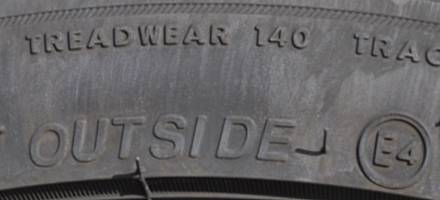Tyre Technology
Tyres designed to rotate in one direction only or with an asymmetric tread pattern must be fitted the right way round.
 Standard car tyres have a symmetrical tread pattern that is the same across the whole width of the tyre.
Standard car tyres have a symmetrical tread pattern that is the same across the whole width of the tyre.
Asymmetric tyres
The tread pattern on an asymmetric car tyre changes across the tread with different parts adapted for particular functions. The outside edge consists of large stiffer tread blocks which help with cornering. The inner tread blocks are smaller and designed to shift water and improve wet grip. The middle of the tread usually has a continuous rib to help straight line stability.
Asymmetric tyres must be fitted the right way round on the wheel to benefit from the tread block arrangement. The sidewalls will be clearly marked.
Directional tyres
Directional tyres usually have a chevron or arrow pattern in the tread and are designed to work in only one direction of rotation.
Directional tyres disperse water that builds up in front of the tyre more effectively, reduce road noise, and improve directional stability. They must rotate in the right direction and this will be clearly marked on the sidewall of the tyre. If a directional tyre is fitted the wrong way round, the tyre won't be dangerous, but you won't gain any of the benefits of it's design.
Incorrect fitting of both asymmetric and directional tyres is a reason for MOT failure. Some high performance cars are fitted with directional and asymmetric tyres. These must be fitted the right way round on the wheel and on the correct side of the vehicle.
Run-flat tyres
You might have to consider run-flat tyres next time you change your car as there are a fair percentage of cars that are fitted from the factory with them. Test drive them first though as the ride will be a lot firmer and tyres a lot more expensive and harder to get repaired. Run-flat tyres have either a reinforced sidewall or additional internal structure to provide partial support to the tyre in a deflated condition and are being offered by more and more manufacturers on new cars.
If you do get a puncture in a run-flat tyre you might not notice, particularly on a motorway, because the ride quality will be very similar to normal (aka, rock hard!). This is why run-flat tyres are always fitted together with a tyre pressure monitoring system (TPMS). There will be restrictions on use following a puncture. The vehicle handbook will give details but in general deflated tyres should be capable of at least 50 miles (range can vary with vehicle load) at speeds up to 50 mph. Tyres should be renewed as soon as possible following a puncture. You should get worn or damaged, run-flat tyres replaced by the same make of run-flat tyre. The TPMS will probably need to be reset after a new tyre has been fitted. Check the handbook for details.
Nitrogen in car tyres
For passenger car tyres the main claims seem to be:
Less corrosion – because unlike air there's no moisture in pure nitrogen.
Slower rate of pressure loss – nitrogen molecules are larger than oxygen molecules.
Air loss can occur through the inner liner of the tyre as well through the valve, punctures, or failure of the seal between tyre and wheel rim.
Pure nitrogen might leak more slowly through the liner, but you would still have to check tyre condition and pressure regularly. Corrosion of the tyre from using normal compressed air is unlikely anyway because only the outer tread band of a car tyre contains steel – the amount of moisture reaching it from the inside is minimal. To change to nitrogen you have to have the air already in the tyres removed before the tyres are re-inflated with purified compressed nitrogen. There will be a one-off charge per tyre but once filled with nitrogen, future top-ups would have to be with nitrogen if any advantages are to be maintained.
To be honest, we don't think that the cost and inconvenience are justified for normal car use and hence why we don't supply it.